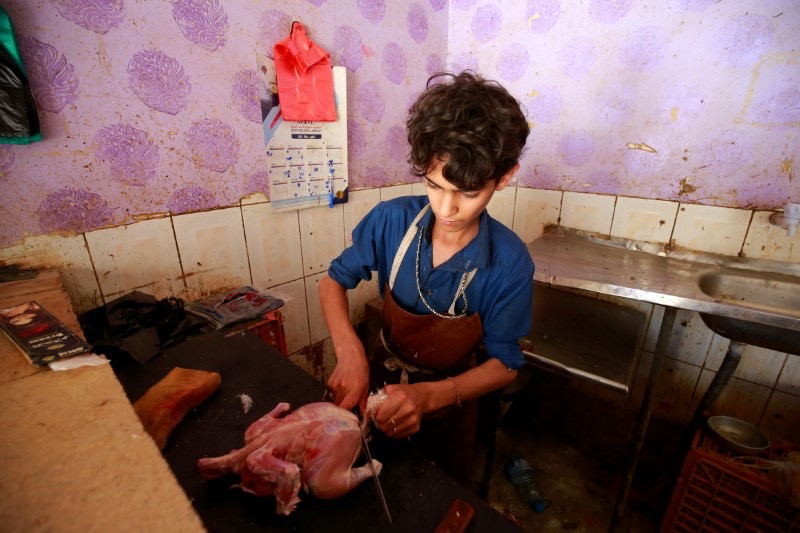Sanaa, Yemen
Reuters
Instead of attending school, 15-year-old Harith Mansour spends his days wringing chickens’ necks, plucking feathers and bagging up fresh meat for customers of a small shop in Yemen’s capital Sanaa.
He is one of an unknown number of Yemen’s children working to keep their families fed and housed as the toll of six years of war pushes the country ever deeper into poverty and hunger.
“I had to take on this job because my father cannot cover household expenses by himself…There isn’t enough for school or other things,” said Mansour, who stopped studying at eighth grade.

Harith Mansour, 15, cuts a chicken at a butchery in Sanaa, Yemen, on 5th July. PICTURE: Reuters/Nusaibah Almuaalemi
Elsewhere in the capital Abdo Muhammad Jamales, also 15 and clad in sandals and a shirt, cuts long steel rebars in the street for use in concrete structures.
Fighting in his home city of Hodeidah in western Yemen displaced his parents and eight siblings to the nearby countryside two years ago. With his father unwell and unable to work, Jamales and his brother moved to Sanaa.
Jamales earns 3,000-4,000 riyals ($US6 to $US7) a day but more than half goes on food and accommodation, with little left to send home.
“Before, I used to study and sit and, thank God, all was good: food and drink came easily. But now it is hard…A flour sack costs 18,000-19,000 riyals. Before it was 5,000-8,000,” he said.
Price inflation in the war-battered economy is a major driver of Yemen’s persistent hunger crisis. The cost of a minimum food basket in Yemen has risen more than 20 per cent this year, according to UN data.
Before the latest conflict erupted in late 2014, Yemen was working with the United Nations to reduce child labour. The minimum age for work was 14, and 18 for hazardous work.
But children’s organisation UNICEF says the war has more than doubled the number of children out of school to two million.
With family budgets at breaking point, girls are being married at earlier ages, boys recruited as soldiers and children sent out to work. More than 3,600 children were recruited into armed conflict in the past six years, the UN has said.
Zakaria Naguib, 16, started working in a metal workshop in Sanaa two years ago.
“It’s this situation [the war] which drove me to work…this work gives us our daily bread,” Naguib said, as sparks from grinding steel flew around his unprotected face.






